How many types of cheese are there?
Blue cheese, yellow cheese, hard cheese, salty cheese, cheese with holes.
Even typewriters would get tired of typing all the different types of cheese in the world.
And the best part is,
They would still manage to forget many of them.
That’s how overwhelming this topic is.
We, however, have found a unique way of going around it.
A way of classification you wouldn’t find around on the internet.
Yes!
Cheese varieties by types of milk.
Excited? Let’s start then.
Table of Contents
Types of cheese according to milk source?

According to Wikipedia, there are 9 most distinctive animals that produce milk.
Out of them, only buffalo, cow, sheep, and goat are used to make cheese.
It’s very difficult to calculate the global share of each milk type in the production of cheese; however, one thing is for sure.
Cow milk is the most used dairy for it.
There are several qualities that the best milk for cheese making should pass. Top cheesemakers like Emmi Roth, Alpha Tolman, Green Hill and Grotta Del Fiorini certainly use these:
- Flavor; it should have a fresh flavor. Not necessarily sweet or salty but extremely original and fresh.
- Level of pasteurization; it shouldn’t be highly pasturized. Anything above 170oF is not very good.
- Cost: Neither should it be too expensive nor should it be of a cheap quality.
- Processing: It should go through clean and hygienic processing.
So, let’s start our cheese list. We have made sure that you get an insight into each cheese type easily without reading words and words on them.
Types of cow cheese
Now, what makes this milk the most desirable diary for the production of cheese?
First, it’s balanced in terms of nutrients.
Second, it is available in plenty.
Here are the top cheeses made from cow’s milk.
1. Cheddar
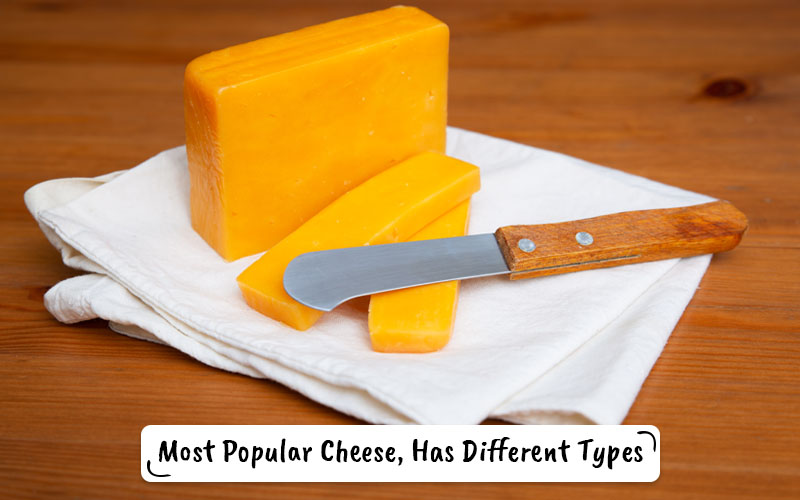
Possibly the world’s most popular cheese, this hails from the village of Cheddar in Somerset, located in England.
Depending on how long it has been aged, it gets different flavors.
Mild or young cheddar cheese is aged 2-3 months, has a smooth texture and a creamy flavor.
The medium one is aged 5-8 months and has a smooth texture with a mid-sharp taste.
Mature or sharp cheddar cheese is aged between 9-16 months, is hard and crumbly with a sharp, acidic taste.
The color can vary from white to orange, depending on the food coloring added. Usually, annatto is added to make it yellowish-orange.
According to USDA, 100g of cheddar cheese include the following.
| Calories | 393 kcal |
| Fat | 32.14g |
| Protein | 25g |
Here is a video of how cheddar is produced in a 100-year old factory.
Best for?
It also contains helpful traces of minerals like calcium, sodium and phosphorus. It can be used as slices to top burgers, melted in raclette to add in pasta and grated to put in quiches.
2. Camembert

This white cheese is home to the Camembert town situated in Normandy, France. Depending on the type, it can be made from raw or pasteurized cow milk.
In order to be called Camembert, the cheese needs to be at least 10 cm in diameter and contain 22% fat content.
It has a soft, runny texture and is made in circular potions. It ages around 4-5 weeks which gives a suitable time for the fungus to surround it completely.
In the start, it is all white but as time is given to it for maturity, brown tinges start to appear on the edges. It has a creamy, nutty and mushroomy flavor with a sharp, pungent smell.
Here are the nutritional details of 100g.
| Calories | 250 kcal |
| Fat | 21.43g |
| Protein | 17.86g |
Best for?
It tastes the best when at room temperature. You can consume it by spreading it on crackers and slices. Also, it is used in salads and melted to be used in sandwiches.
3. Parmesan (Parmigiano-Reggiano)

The king of cheeses, Parmesan is called as such due to two reasons.
- It is one of the most expensive cheeses in the world.
- It is the most aged cheese in the world (2 years normally, some are aged for 10 years)
This hard, yellow cheese hails from Northern Italy and has a fruity flavor with a granular texture. It loves to be shredded and minced.
Protected under the DOP Status (which affirms that the cheese can only come from its origin), it is one of Italy’s biggest export. Only 329 factories in the world produce Parmesan cheese.
It takes 131 gallons of milk to produce a single wheel of cheese (Food Insider) – hence the high price. During the process, it is brined for 19 days.
Below is what 100 g of Parmesan offers
| Calories | 392 kcal |
| Fat | 25 g |
| Protein | 35.75 g |
| Carbohydrates | 3.22 g |
Best for?
Parmesan cheese has a strong flavor and is seldom consumed solely – it is shredded over pastas and pizzas, mixed with batter to form cookies and sprinkled over casseroles or salads.
4. Brie

The cousin of Camembert, Brie, originates from the town of Meaux, France and has the same texture; soft and creamy with a chewy rind.
But what are the differences?
Brie is packed in a larger wooden box, has more fat content (29% compared to 22%) and is matured for more time than Camembert. It also has a more fine flavor in comparison to a rustic taste.
100g of Brie include the following:
| Calories | 357 kcal |
| Fat | 32.14 g |
| Protein | 17.86 g |
Best for?
People, especially in France, use it in salads and melt it in steaks or use it in a raw state with caramelized apples or honey.
Enjoy it with garlic bread or toasted slices. You can also pair it up scrumptiously with grapes and red wine.
5. Mozarella

Although traditional Mozarella is made with water buffalo, but nowadays, it is commonly made with cow’s milk.
Regarded as a semi-soft cheese, this is the top Italian cheese and go head to head with the cheddar cheese in different parts of the cheese-loving countries like France, Germany, Finland and Greece.
There are different types of Mozarella cheese; some say 6, some say 12.
But, let’s just say there are above 10 to be safe.
Here are the most popular ones:
- Fresh mozzarella: It has a milky taste, is quite soft in texture and is consumed in salads or solely in breakfasts/lunch with olive oil.
- Mozarella di Bufala: Made from the buffalo milk (which is the traditional milk used for making mozzarella). It is a bit sweet.
- Smoked mozzarella: You get the gist of it, right? Wood chips like chestnut, alder and cherry are used to smoke it and it gives it a cooked taste with brownish rind.
- Burrata: Its simply warm mozzarella mixed with cream and stracciatella. What you get is a rich, runny creamy cheese when you slice it.
- Mass-produced: This is the layered cheese without water you see at most grocery stores. It is firm and is most commonly used in pizzas, pasta and lasagnas. The flavor is a bit salty.
Because there are so many types of this cheese, it is difficult to assign a single taste to mozzarella. It can be regarded, however, as being milky, fresh and slightly acidic with a chewy texture.
It is normally short-aged, which is between two to four weeks. We won’t recommend to keep it for long in the fridge as it loses it’s original taste and creaminess just like cream, which lasts for about 2 weeks as well.
Here’s the table:
| Calories | 321 kcal |
| Fat | 28.57 g |
| Protein | 17.86 g |
| Carbohydrates | 3.57 g |
6. Gouda
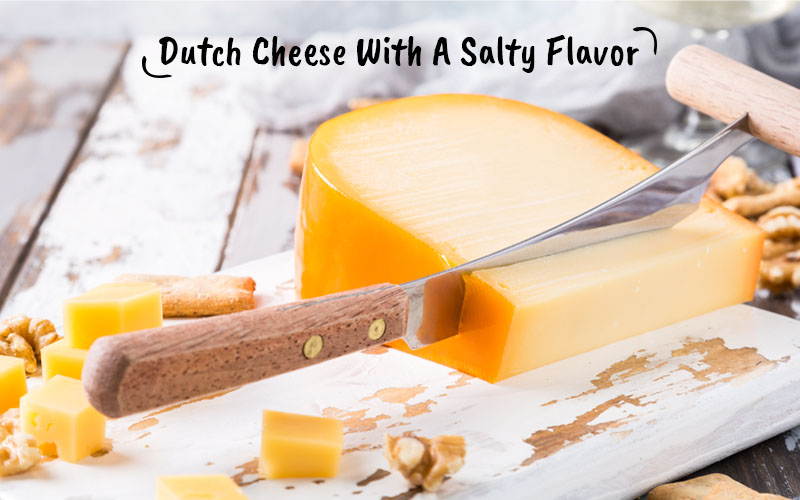
You might have consumed Gouda cheese but did you know that it belongs to the Netherlands? The reason it is called Gouda is because it was sold in the city called Gouda traditionally (and it still does).
This semi-hard cheese has got different taste depending on the aging time:
- Young: Aged for 4-10 weeks
- Mature Gouda: Aged for 16-18 weeks
- Old Gouda: Aged for 10-12 months
Young Gouda is soft and has a somehow sweet taste, so is best to be used for sandwiches, bread and crackers.
Mature Gouda converts to a salty and nutty flavor which is ideal for wines and burgers.
Old Gouda has got a salty richness to it and is served most purposefully in salads or with wines like Shiraz.
The best way to store Gouda is by using stretchy storage lids or in plates/bowls using vacuum covers.
100 g of Gouda cheese include (USDA data):
| Calories | 419 kcal |
| Fat | 42.86 g |
| Protein | 33.33 g |
Best for?
This cheese type can be used in all melted cheese dishes like soups, sandwiches, quiches and macaroni.
7. Emmentaler

Raise hands if you have noticed the holed cheese in the Tom & Jerry cartoons!
That’s Emmentaler cheese.
It hails from the region of Switzerland which produces about 80% of the Emmental cheese; also referred to as Swiss cheese in the US.
With a smooth texture, yellow color and a fruity flavor, its most iconic feature are the holes which is the result of the CO2 production from the bacteria during the storage process.
It ages for about 8-10 months before coming into the hands of the wholesaler.
Here’s how it is made, stored, processed and tastes like.
You get a good amount of proteins from it:
| Calories | 393 kcal |
| Fat | 32.14 g |
| Protein | 28.57 g |
It is the world’s most cheated cheese as well so the real Emmental cheese will always come with a reference number and a logo on the rind (if you cut a large piece).
Best for?
Due to its good melting properties, it is mainly used in cheese fondue, cheeseburgers/sandwiches and casseroles.
Types of sheep cheese
You wouldn’t see many sheep cheese farms in the world because they just don’t give that much of milk.
But here’s a catch!
A gallon of cow’s milk gives you a pound of cheese
A gallon of sheep’s milk gives you three pounds of cheese
It’s that rich.
People making traditional sheep cheese take pride in what they do.
Oh, let’s not get carried away. Towards the topic now :p
Sheep milk cheese has a high percentage of butterfat and is defined for its sharp flavors. It contains more lactose and minerals than the milk of goat or cow.
Also, the fat globules are smaller which makes it easier to digest and there are thus fewer chances of high cholesterol.
Top sheep’milk cheese varieties are the following:
8. Pecorino Romano

This hard, pale and salty cheese trails back to the villages of Italy 2000 years ago where it is still cherished for its natural aroma and crumbly texture.
It is one of the most aged cheeses and comes in three types, divided by the time of aging:
- Fresco: aged for 30 days
- Semi-stagionato: less than a year
- Stagionato: 24-36 months
The more aged it is, the more salty, hard and crumbly it is. Many people find the Stagionato Pecorino to be very strong and not suitable for sole use. It is grated to be added in pasta or sauces.
A proper circle of taste flows through a chunk of Pecorino placed on the tongue.
At first, it delivers a hint of nuttiness which immediately shifts to a salty flavor before regaining the final comprehensiveness of an earthy, crumbly savor.
Here is the nutrition table:
| Calories | 393 kcal |
| Fat | 32.14 g |
| Protein | 28.57 g |
| Carbohydrates | 3.57 g |
Best for?
This is a great grating cheese option for dishes like pasta, pizzas, soups and patties. It can also be sprinkled magnificently over vegetables and potatoes.
Though the rind is very hard, it added to the stews/soups as a taste enhancer.
Pecorino vs Parmesan

People usually tend to confuse Pecorino with Parmesan. They are both different.
While Pecorino is made from 100% sheep’s milk, Parmesan is derived from cow’s milk. It is softer than the Parmesan but achieves the hardness relative to Parmesan within a few months.
It is lighter in color and has a milder taste in comparison as well.
9. Roquefort

One of the best blue cheese in the world, the Roquefort comes from France and is called the “King of Cheese” locally.
It is renowned for its blue veins, chunky texture and nutty, salty flavor. Roquefort is the natural mold that is found in the caves of France.
Its varieties (usually penicillium roqueforti) are added as a requisite during the preparation to give cheese the blue color; rennet and the bacteria culture being the other two.
It has a pale yellow color before the mold starts to show its magic. Generally, the mold would take about 1-2 months to propagate throughout the cheese wheel after which it is packed.
It is left to age for further 1-3 months which takes the total aging period to 5-6 months.
The video explains beautifully how it is made.
| Calories | 357 kcal |
| Fat | 32.14 g |
| Protein | 17.86 g |
Best for?
Mostly used in dressings and salads, it is also spread on crackers and toasts or consumed with rich-taste honey as well as wines.
10. Manchego

It’s hard to keep Spain away from all the cheese discussion.
This semi-hard cheese comes from La Mancha region of central Spain and integrates the fruity essence of sheep’s milk with sweetness and spiciness it gets from the mold which covers the wheel.
Another distinctive feature is the herringbone rind and it needs to be matured/aged for at least 2 months to be called Manchego.
Although it is made in Mexico as well but it shares little similarity with the traditional Spanish recipe. In Mexico, it is made with cow’s milk and is matured for only 2 weeks so it is soft and squishy.
Due to this mismatch, Spanish cheesemakers don’t approve of sharing the name of their cheese and is granted the Protected Designation of Origin.
| Calories | 429 kcal |
| Fat | 35.71 g |
| Protein | 25 g |
| Carbohydrates | 3.57 g |
Best for?
Manchego melts perfectly and is mainly used in making empanadas and egg dishes.
Types of goat cheese
Cheese made from goat is softer and generally contains more proteins and fat than cow’s milk. There are many low-quality varieties of sheep cheese out there in the market which has somehow shunt the interest of customers towards this type.
Here’s three of them which you must try.
11. Feta
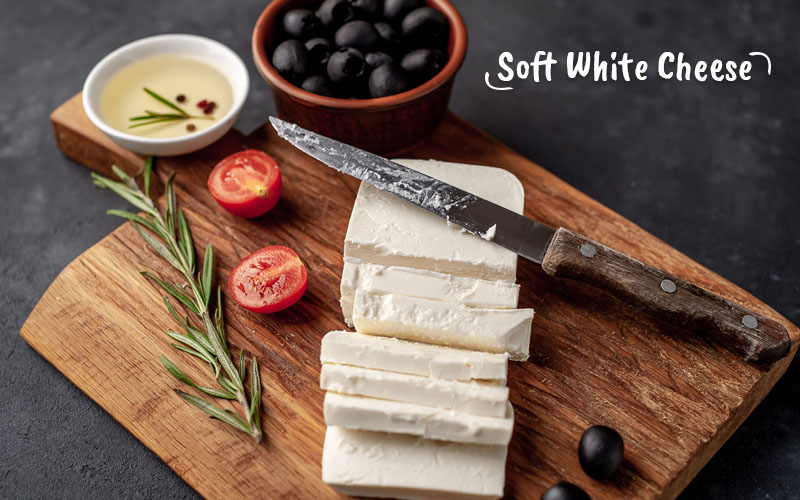
Feta is made either with a combination of goat and sheep milk or solely with sheep’s milk.
It belongs to the land of Greece and is distinctive for its white color, crumbly, soft texture and a mild taste. It is usually made in the form of slices.
The minimum maturing time for Feta cheese is 2 months within which it is brined, although different producers age it for different periods – hence different types.
Some are runny and creamy while others, more matured ones, are firm and tangy.
This is what 100g of Feta cheese include:
| Calories | 286 kcal |
| Fat | 21.43 g |
| Protein | 17.86 g |
| Carbohydrates | 3.57 g |
Best for?
They are added in fruit salads including sliced apples, peaches, mangoes and grapes; marinated in olive oil or eaten grilled.
12. Bucheron

Hailing from the Loire Valley of France enriched with fresh, wide pastures of grass, this cheese has a semi-soft consistency and is made in the form of a log.
In fact, had been the color brown, people would easily mistake it for being wooden logs. The rind has a scaled pattern while the center is chalky.
The diet of the goats from which the milk is derived plays a vital role in determining the taste of the cheese; however generally, it has an earthy, citrusy flavor with notes of mushroom.
Here’s a simple recipe of making goat cheese at home using a starter, colander bowl and some salt.
| Calories | 250 kcal |
| Fat | 21.43 g |
| Protein | 14.29 g |
| Carbohydrates | 3.57 g |
13. Valencay
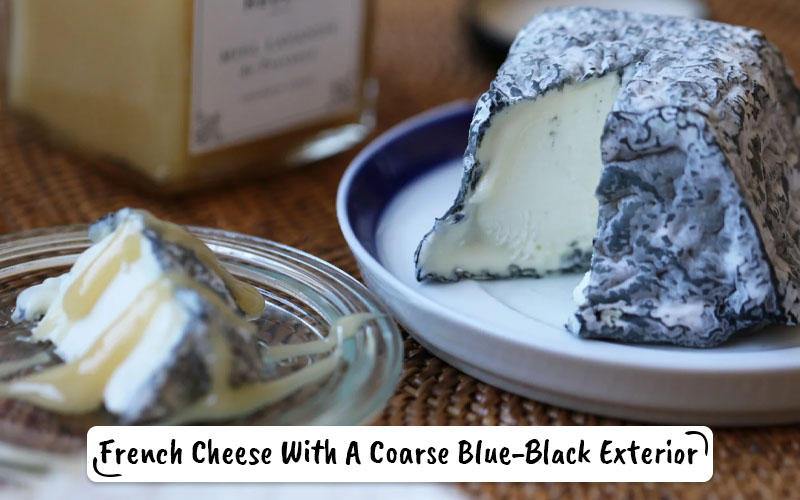
Valencay is a French cheese made with fresh goat milk. This cheese is made in a truncated pyramid shape – its distinctive feature.
The cheese is pale white to yellow after being prepared so how does it get the blue-black hue?
Actually, it is covered by vegetable ash and left to age for 4-5 days in the industries’ caves. After being covered with suitable culture for further 4-5 days, it converts to a wrinkled blue-black consistency – the final shape.
It is soft, and has a citric taste when fresh – this changes to a nutty savor with time. It is not aged for more than 2 months.
Types of buffalo cheese
Buffalo milk is thicker and creamier than the cow’s milk as it contains more fat. Here are the two types of buffalo milk cheese.
14. Caciotta

This semi-soft white colored cheese is made and treasured in Italy. Although cow’s and sheep’s milk is also used to make it, we will be talking about the buffalo version only.
It is aged for about 2 months and has a sweet, creamy taste. Much interestingly, it is seasoned with different ingredients like red pepper, onion or herbs.
In the factories, it is aged for at least a month before the final packaging. A humidity of 75-85% is required for this cheese to mature perfectly.
100g of Caciotta cheese include the following:
| Calories | 357 kcal |
| Fat | 28.50 g |
| Protein | 24 g |
| Carbohydrates | 1.14 g |
Best for?
Caciotta cheese can delectably be a part of omelets, quiches and pies.
15. Paneer
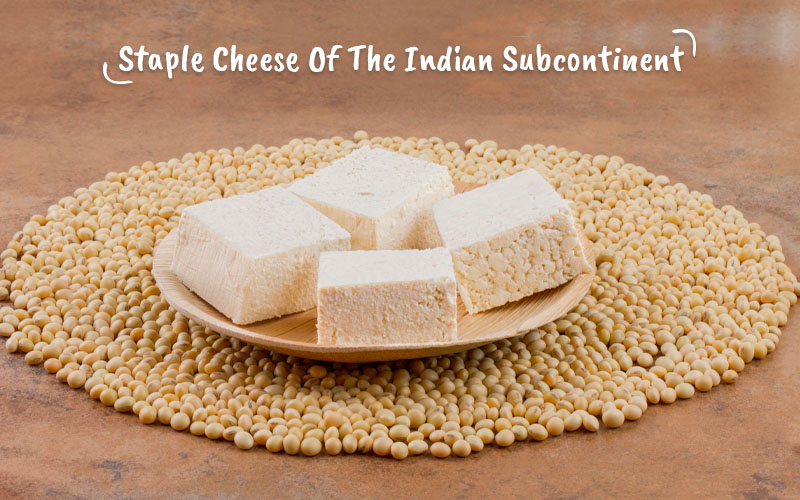
Cottage cheese or Paneer is a staple food of the Indian subcontinent. It is made in the plain, spicy or pickled form. It is soft and jet white in color with a milky taste.
The presence of a good amount of carbohydrates in Paneer makes it sa suitable staple food. In fact the poor regions of India prepare them at home rather than buying from outside and feed their kids with it.
The fact to keep in mind about this type is that it doesn’t melt and is not aged. Some people consider Paneer to be bland and thus the spicy and picked varieties.
In the factories, it is made in the form of cubes, tins and slices, after which it gets transported all around the world.
| Calories | 343 kcal |
| Fat | 26.9 g |
| Protein | 19.1 g |
| Carbohydrates | 6.1 g |
Best for?
Top paneer dishes are Palak Paneer, Matter Paneer, Kofta and Paneer Tikka Masala.
Wrap-up
We know we might have missed many cheese kinds of your country.
So why not ping us about them in the comment section so we can include them in our blog.
Happy cheesing!

